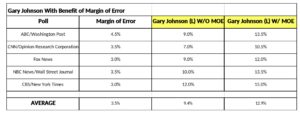by Kody Fairfield

Earlier in August, it was announced by the Commission on Presidential Debates (CPD), that in order for any of the presidential nominees of any party to qualify for the up coming presidential debates they would have to meet the following criteria:
The polls to be used by the CPD in 2016 are:
ABC-Washington Post
CBS-New York Times
CNN-Opinion Research Corporation
Fox News
NBC-Wall Street JournalThe CPD’s 2016 Candidate Selection Criteria were announced on October 29, 2015. They will be applied in mid-September, 2016. If a candidate is invited to the first presidential debate, that person’s vice presidential running mate will be invited to the vice presidential debate. The criteria will be reapplied between the first and second presidential debates and the second and third presidential debates.
The CPD’s nonpartisan criteria for selecting candidates to participate in the 2016 general election presidential debates are:
-
Evidence of Constitutional EligibilityThe CPD’s first criterion requires satisfaction of the eligibility requirements of Article II, Section 1 of the Constitution. The requirements are satisfied if the candidate:
- is at least 35 years of age;
- is a Natural Born Citizen of the United States and a resident of the United States for fourteen years; and
- is otherwise eligible under the Constitution.
-
Evidence of Ballot AccessThe CPD’s second criterion requires that the candidate qualify to have his/her name appear on enough state ballots to have at least a mathematical chance of securing an Electoral College majority in the 2016 general election. Under the Constitution, the candidate who receives a majority of votes in the Electoral College, at least 270 votes, is elected President regardless of the popular vote.
-
Indicators of Electoral SupportThe CPD’s third criterion requires that the candidate have a level of support of at least 15% (fifteen percent) of the national electorate as determined by five national public opinion polling organizations selected by CPD, using the average of those organizations’ most recent publicly-reported results at the time of the determination.
Given the information set forth here, its pretty easy to say that the two major parties, Democrats and Republicans, should qualify for the debates without issue. Especially since they are typically given more air time in the media, they tend to have a far larger war chest, and their national committee’s structure allow them to coordinate nationwide organization quickly. On top of this, the two major parties national committees may or may not have a large lobbying role in the CPD.
When it comes to the minor parties, Libertarian and Green Party, the criteria appears to be a bit more daunting. These parties already battle more difficult ballot access laws and litigation, and do not receive equal public funding that the major parties do. Not to mention the fact that they are largely ignored by the media because of the duopoly that has been created, with help from their lobby to the CPD. The duopoly then force feeds the citizens ideas of irrelevancy towards the minor parties, leading to a situation that has gotten so bad that nearly every election comes down to what has been called a pick from the lesser of two evils.
All the information about the difficulties not withstanding, these are the guidelines. Taking a look at the latest polling as of 9/11/2016 from the 5 polls being counted toward the 15% average needed to qualify, here is what they show.

Looking at the current polls, its odd to see such a differential in all of the margin of errors, bouncing from 3-4.5%. What this means is that any one of the candidates numbers could be misrepresented with in an error of 3-4.5% higher or lower of their number shown. For instance lets look at Libertarian candidate Gary Johnson. The chart below describes the drastic difference in the poll numbers for Johnson, given the benefit of the margin of error.

Now, this is a simplistic chart simply showing just the change in Johnson’s number without the affect of pulling the percentages from other candidates numbers. Beyond that, it demonstrates how different polling numbers can be if the margin of error comes in to play, and when you are looking at allowing candidates on the cusp of the required 15% needed to get into the debates, could it not be argued that the margin not should come into play?
Its clear that even with the margin included the minor party candidates have some work to do. Jill Stein would need to climb double digits, but Johnson would only need a small bump in one or two of the polls counted.
Do we continue to pretend that some arbitrary, non-elected, and major party influenced group of people get decide what voices are relevant for the American people to hear? It should be time to openly discuss how we run our debates, and how we determine the criteria for candidates to make it on the stage. We the People should determine the voices they want heard, to allow for the best education on our representation. There is no reason we should continue to be relegated to a choice of the lesser of two evils.



4 comments
… [Trackback]
[…] Read More here on that Topic: thelibertarianrepublic.com/commission-on-presidential-debates-margin-of-error-rather-large/ […]
… [Trackback]
[…] Information on that Topic: thelibertarianrepublic.com/commission-on-presidential-debates-margin-of-error-rather-large/ […]
… [Trackback]
[…] Find More here to that Topic: thelibertarianrepublic.com/commission-on-presidential-debates-margin-of-error-rather-large/ […]
… [Trackback]
[…] There you will find 86716 more Information on that Topic: thelibertarianrepublic.com/commission-on-presidential-debates-margin-of-error-rather-large/ […]